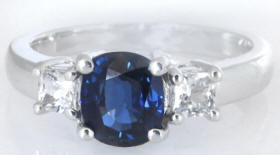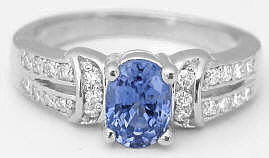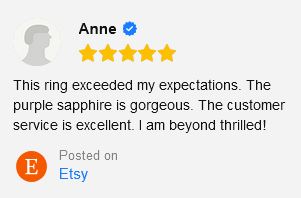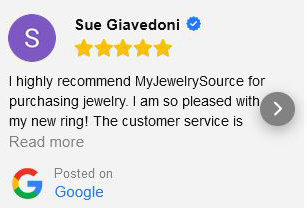|
Become an Insider & receive
up to 25% off!
|
 |
|
- -
|
Blue Sapphire RingsOur collection of blue sapphire rings lies at the heart of our offerings, timeless, elegant, and endlessly versatile. Featuring natural sapphires in a range of hues from soft pastel periwinkle to rich navy blue, these rings are available in styles from simple solitaires to ornate vintage designs. Whether delicate or bold, each piece highlights the beauty and individuality of this cherished gem.This page is pre-sorted from low to high price |
  |
| 0.60 ctw Square Cut Channel Set Sapphire Ring in 14k yellow gold |
In Stock GR-5035$1229 |
 |
| Pave Set 0.86 ctw Blue Sapphire Ring in 14k white gold |
In Stock GR-5632$1359 |
  |
| Petite 0.72 ctw Ceylon Round Blue Sapphire and Diamond Ring in 14k white gold |
In Stock BR-130$1609 |
 |
| 0.82 ctw Ceylon Sapphire, Pink Sapphire and Baguette Diamond Ring in 14k yellow gold |
In Stock BR-124$1689 |
 |
| 1.09 ctw Ceylon Round Blue Sapphire and Diamond Ring in 14k white gold |
In Stock BR-129$1799 |
  |
| Petite 0.90 ctw Ceylon Blue Sapphire and Baguette Diamond Ring in 14k white gold |
Ships in 1-3 weeks GR-5637$1719 Special Order |
 |
| 0.90 ctw Ceylon Sapphire and Baguette Diamond Ring in 14k yellow gold |
Ships in 1-3 weeks GR-5760$1719 Special Order |
 |
| 1.27 ctw Blue and White Sapphire Three Stone Ring in 14k white gold |
Ships in 2-3 weeks GR-5837-WS$1849 |
| Customer Testimonial more testimonials... |
|
Thanks you so much for all the effort you put into finding my sapphire ring. It's just what I had in mind. You have been wonderful to work with and I hope to again when I get earrings. I never bought any jewelry on the internet but you made the experience so easy. I would feel comfortable telling my friends. Thanks again and Happy New Year! D.D., Nashville, TN |
  |
| 1.5 ctw Ruby, Sapphire, Emerald and Diamond Accent Ring 14k yellow gold |
In Stock GR-4016$2049 |
  |
| 0.60 carat Semi Bezel Oval Blue Sapphire and Diamond Ring in 14k white gold |
In Stock GR-5153$2119 |
  |
| 1.20 ctw Channel Set Blue Sapphire and Diamond Ring in 14k white gold |
In Stock GR-5171$2109 |
 |
| 1.27 ctw Blue and White Sapphire Three Stone Ring in 14k white gold |
In Stock BR-113$2289 |
  |
| 1.57 ctw Shades of Blue Sapphire Band Ring in 14k yellow gold |
In Stock GR-5229$2389 |
  |
| 1.64 ctw Dark Blue Sapphire and Princess White Sapphire Ring in 14k white gold |
In Stock BR-112$2369 |
 |
| 1.6 ctw Princess Cut Sapphire Eternity Band in Platinum |
In Stock GR-5575$2179 |
  |
| 1.06 carat Round Sapphire Solitaire Ring in 14k white gold |
In Stock GR-5944$2349 |
  |
| 1.43 ctw West Set Blue Sapphire and Baguette Diamond Ring in 18k white gold |
In Stock GR-5469$2469 |
 |
| 1.23 ctw Blue Sapphire and Diamond Three Stone Ring in 14k white gold |
Ships in 1-3 weeks GR-5837$2389 |
  |
| Timeless 1.25 ctw Oval Sapphire and Diamond Ring in 14k yellow gold |
Ships in 2-3 weeks GR-5074$2519 |
  |
| Classic 1.41 ctw Blue Sapphire and Diamond Ring in 14k white gold |
Ships in 2-3 weeks GR-5457$2569 |
  |
| 1.08 ctw Ceylon Oval Sapphire and Diamond Ring in 14k white gold |
Ships in 1-3 weeks BR-119$2649 |
  |
| 1.08ctw Ceylon Sapphire and Diamond Ring in 14k yellow gold |
Ships in 1-3 weeks BR-118$2649 |
  |
| 1.29 ctw Emerald Cut Blue Sapphire and Diamond Ring in 14k
white gold Princess Diana Inspired |
Ships in 2-3 weeks GR-5099-W$2609 Special Order |
  |
| 1.09 ct Ceylon Radiant Cut Sapphire Solitaire Ring in 14k white gold |
Ships in 1-3 weeks GR-5440$2729 |
  |
| Premium 1.7 ctw Ceylon Blue Sapphire Ring in 14k white gold |
In Stock GR-5648$2879 |
  |
| 1.32 ctw Oval Sapphire and Pave Diamond Ring in 14k yellow gold |
In Stock GR-5068$2849 |
  |
| Delicate 1.98 ctw Ceylon Blue Sapphire and Diamond Ring 14k white gold |
In Stock BR-127$2769 |
  |
| 1.60 ctw Round Sapphire and Diamond Ring in 14k white gold |
Ships in 1-3 weeks BR-115$2849 |
  |
| 1.26 ctw Ceylon Sapphire and White Sapphire Ring in 14k white gold |
In Stock BR-114$3049 |
  |
| 1.23 ctw Blue Sapphire and Diamond Ring in 14k white gold |
In Stock GR-5729$3219 |
  |
| 1.36 ctw Oval Sapphire and Diamond Ring in 14k white gold |
Ships in 1-3 weeks GR-5720$3239 |
  |
| 1.86 ctw Oval Blue and Trillion White Sapphire Ring in 14k white gold |
In Stock GR-5412$3279 |
  |
| 1.26 ctw Blue Sapphire Heart and Diamond Ring in 14k white gold |
In Stock GR-5540$3439 |
 |
| 1.94 ctw Ceylon Sapphire and White Sapphire Ring in 14k white gold |
In Stock BR-125$3409 |
  |
| 1.48 ctw Square Cut Sapphire and Baguette/Round Diamond Ring in 14k white gold |
In Stock GR-5194$3439 |
  |
| 1.94 ctw Ceylon Sapphire and White Sapphire Ring in 14k white gold |
In Stock BR-111$3449 |
 |
| 1.89 ctw Blue Sapphire and Oval Diamond Ring in 14k white gold |
Ships in 2-3 weeks GR-5269$3379 Special Order |
  |
| 2.09 ctw Blue Sapphire and Diamond Ring in 14k white gold |
In Stock GR-5588$3639 |
  |
| 2.46 ctw Ceylon Blue and White Sapphire Three Stone Ring in 14k white gold |
In Stock BR-110$3609 |
  |
| 1.49 ctw Ceylon Blue Sapphire and Diamond Ring in 14k |
In Stock GR-5983$3479 |
 |
| 1.34 ctw Ceylon Radiant Cut Sapphire and Diamond Ring in 14k white gold |
Ships in 2-3 weeks GR-5965$3729 Special Order |
  |
| 1.25 ctw Ceylon Sapphire and Diamond Ring with 0.26 ctw Matching Diamond Band |
In Stock GR-5931$3969 |
  |
| 1.44 ctw Round Cut Sapphire and Diamond Ring with 0.18 ctw Diamond Band in 14k white gold |
In Stock GR-5926$3919 |
  |
| Premium 1.36 ctw Sapphire and Diamond Ring in 14k white gold |
Ships in 2-4 weeks GR-5586$3949 Special Order |
  |
| 1.38 ctw Ceylon Blue Sapphire and Diamond Ring in 14k white gold |
Ships in 1-3 weeks GR-5695$4049 Special Order |
  |
| 1.46 ctw Emerald Cut Sapphire and Diamond Ring in 14k white gold |
Ships in 2-4 weeks BR-117$4009 Special Order |
  |
| 1.84 ctw Sapphire and Diamond Ring in 14k white gold |
Ships in 2-3 weeks BR-101$4109 Special Order |
  |
| 1.4 ctw Pave Blue Sapphire and Diamond Band Ring in 18k yellow gold |
In Stock GR-5009-y$4599 |
  |
| 1.51 ctw Blue Sapphire and Diamond Ring in 14k white gold |
Ships in 2-3 weeks GR-5680$4559 Special Order |
  |
| 2.23 ctw Princess Cut Sapphire and White Sapphire Ring in 14k white gold |
In Stock BR-102$4579 |
  |
| 1.47 ctw Princess Cut Ceylon Blue Sapphire and Diamond Ring in 14k white gold |
Ships in 2-4 weeks GR-5772$4479 Special Order |
  |
| 1.77 ctw Sapphire and Trillion Diamond Ring in 14k white gold |
In Stock GR-5564$4789 |
| Fun Fact: In ancient times, people believed that blue sapphires could neutralize poison and prevent illness. Royalty and nobility often wore them as a protective charm, convinced that the gemstone could safeguard them against treachery and assassination attempts. Some even ground sapphires into powders for medicinal purposes, believing they could cure ailments and strengthen the immune system. Legends also claimed that a sapphire's color would fade if worn by someone unworthy or deceitful, making it a symbol of truth and integrity. |
Sapphire In the NewsThe latest developments in the world of gemstones and jewelry Last Update: November 20, 2025Padparadscha SapphireSummary: The article discusses the rarity and increasing popularity of Padparadscha sapphires in the jewelry market. These unique gemstones, known for their pink-orange hue, are highly sought after by collectors and jewelry enthusiasts for their distinctive color and limited availability. The article highlights the growing demand for Padparadscha sapphires in high-end jewelry pieces and the rising prices reflecting their scarcity and desirability in the market.
Read More (opens in new window)
Use of Yellow Sapphire in stressful Rahu Periods for a Better Life with Jyotish Gemstones Therapy| Cutting Fire with FireSummary: The article discusses the use of Yellow Sapphire in Jyotish Gemstones Therapy during stressful Rahu periods for a better life. It highlights the belief that certain gemstones, like Yellow Sapphire, can help counter negative influences and promote well-being, particularly in the realm of astrology and gemstone therapy. Jewelry professionals and enthusiasts interested in gemstone therapy and astrology may find this article insightful for understanding the potential benefits of Yellow Sapphire during challenging periods.
Read More (opens in new window)
|
What's the latest news on Sapphires?
Sapphire In the News
The latest developments in the world of gemstones and jewelry
Last Update: November 20, 2025Padparadscha Sapphire
Use of Yellow Sapphire in stressful Rahu Periods for a Better Life with Jyotish Gemstones Therapy| Cutting Fire with Fire
Are blue sapphires natural or treated?
Most blue sapphires on the market today are natural gemstones that have undergone heat treatment, a widely accepted industry practice. This process involves exposing the sapphire to high temperatures to enhance its color and clarity, mimicking the natural conditions under which sapphires form deep within the earth. Heat treatment is considered permanent and stable, and it does not require any special care beyond whats recommended for untreated sapphires. It is important to note that heat treatment is not considered deceptive -- reputable jewelers disclose it and consumers recognize it as a standard enhancement that adds beauty and value.
In contrast, untreated blue sapphires -- those that have not undergone any enhancements -- are extremely rare and often command significantly higher prices due to their natural, unaltered state. For collectors and purists, untreated sapphires may hold additional appeal, but they are not necessarily more durable or better suited for daily wear than their heat-treated counterparts. In fact, the vast majority of fine-quality sapphires seen in engagement rings and high-end jewelry are heat treated, offering vibrant color and excellent clarity at a more accessible price point.
There are, however, other treatments beyond heating that are sometimes applied to sapphires -- and buyers should be cautious about these. Diffusion treatment, for example, involves adding coloring agents like beryllium or titanium during heating to artificially alter the sapphire's color. This process often results in surface-level color that doesnt extend throughout the stone, and the effect may not be permanent. Such sapphires are often less valuable, and diffusion treatment is not widely accepted in the fine jewelry industry. At MyJewelrySource, we do not use diffusion-treated sapphires we are committed to offering only traditionally heat-treated or untreated stones with full disclosure.
How do I choose a quality sapphire? What should I look for?
When choosing a sapphire, color is the most important factor. Blue sapphires come in a range of hues, from the palest baby or periwinkle blue to the deepest darkest navy blue. Sapphires actually are found in every color of the rainbow. The most prized stones often have a velvety or royal blue color with strong saturation and excellent transparency. Pale or overly dark sapphires tend to be less valuable. What matters most, though, is that the color appeals to you -- beauty is personal, and each sapphire is unique.
Clarity is also a consideration, though not as strict as it is with diamonds. Most sapphires have some natural inclusions, and these are generally acceptable as long as they dont affect the gems beauty or durability. At MyJewelrySource.com, we focus on offering sapphires that are eye-clean and nearly loupe clean in most cases; inclusions aren't visible without magnification. A clean appearance enhances the stones brilliance and overall appeal.
Next is cut, which greatly impacts how lively the sapphire appears. While diamonds are cut to precise standards, sapphires are typically cut to maximize color and retain carat weight. A well-cut sapphire will reflect light evenly across the surface, without windows (dull areas) or overly deep pavilions. Look for symmetrical outlines and good proportions -- even if the gem isnt perfectly calibrated. In short, the cut should showcase the color beautifully and create a pleasing sparkle.
Carat weight affects price significantly, but its not just about size. Sapphires over 1 carat are considered important, and as size increases, prices rise steeply -- especially if the quality is high. When choosing the right size, think about your lifestyle, budget, and preferences. Some clients prefer a bold, statement piece; others value practicality or subtle elegance. The best investment is one that balances beauty, wearability, and personal significance to you.
You'll also want to consider whether the sapphire has been treated. The vast majority of sapphires are heat treated to improve their color and clarity a permanent and widely accepted enhancement. However, you should avoid sapphires that have been diffusion treated or filled, as these are less stable and much lower in value. At MyJewelrySource.com, we fully disclose any treatments and only offer stones that meet high standards for authenticity, durability, and long-term beauty.
Finally, choosing the right sapphire comes down to your priorities. Are you drawn to a specific color hue? Do you prefer classic or modern settings? Are you shopping for a symbolic occasion or just because you love beautiful jewelry? Sapphires are incredibly versatile, durable, and meaningful -- whether you're buying a ring to wear every day or a once-in-a-lifetime gift. When you choose a sapphire that speaks to your heart and fits your lifestyle, youll treasure it for years to come.
Do blue sapphires lose their sparkle or fade over time?
Blue sapphires are incredibly stable and do not fade over time under normal wear and care. Unlike lower-quality gems or heavily treated stones, natural sapphires especially those that are heat-treated only retain their color and brilliance for a lifetime. They are resistant to light, heat, and most environmental factors, which makes them an ideal choice for everyday wear. You can confidently wear a blue sapphire ring daily without worrying that its color will dull or wash out.
That said, extremely rare exceptions do exist. Some low-quality or artificially treated sapphires, such as those altered with irradiation or certain types of diffusion, may not be fully stable and could show color changes over time. These are not the types of sapphires we offer. The sapphires at MyJewelrySource.com are either untreated or traditionally heat-treated, and are selected specifically for their long-term beauty and durability.
Sapphires also do not become cloudy over time unless they accumulate residue from daily wear. Buildup from hand lotion, soap, or hard water can temporarily dull a sapphires surface, giving it a hazy or cloudy appearance. This is easily resolved with gentle cleaning using warm water, mild soap, and a soft brush. With minimal maintenance, your sapphire will remain bright, clean, and beautiful for generations to come.










